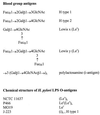Phase variation in Helicobacter pylori lipopolysaccharide due to changes in the lengths of poly(C) tracts in alpha3-fucosyltransferase genes
- PMID: 10496917
- PMCID: PMC96892
- DOI: 10.1128/IAI.67.10.5361-5366.1999
Phase variation in Helicobacter pylori lipopolysaccharide due to changes in the lengths of poly(C) tracts in alpha3-fucosyltransferase genes
Erratum in
- Infect Immun 1999 Dec;67(12):6715
Abstract
The lipopolysaccharide (LPS) of Helicobacter pylori expresses the Lewis x (Lex) and/or Ley antigen. We have shown previously that H. pylori LPS displays phase variation whereby an Lex-positive strain yields variants with different LPS serotypes, for example, Lex plus Ley or nonfucosylated polylactosamine. H. pylori has two alpha3-fucosyltransferase genes that both contain poly(C) tracts. We now demonstrate that these tracts can shorten or lengthen randomly, which results in reversible frameshifting and inactivation of the gene products. We provide genetic and serological evidence that this mechanism causes H. pylori LPS phase variation and demonstrate that the on or off status of alpha3-fucosyltransferase genes determines the LPS serotypes of phase variants and clinical isolates. The role of the alpha3-fucosyltransferase gene products in determining the LPS serotype was confirmed by structural-chemical analysis of alpha3-fucosyltransferase knockout mutants. The data also show that the two alpha3-fucosyltransferase genes code for enzymes with different fine specificities, and we propose the names futA and futB to designate the orthologs of the H. pylori 26695 alpha3-fucosyltransferase genes HP0379 and HP0651, respectively. The data also show that the alpha3-fucosylation precedes alpha2-fucosylation [corrected], an order of events opposite to that which prevails in mammals. Finally, the data provide an understanding at the molecular level of the mechanisms underlying LPS diversity in H. pylori, which may play an important role in adaptation to the host.
Figures
References
-
- Alm R A, Ling L L, Moir D T, King B L, Brown E D, Doig P C, Smith D R, Noonan B, Guild B C, deJonge B L, Carmel G, Tummino P J, Caruso A, Uria-Nickelsen M, Mills D M, Ives C, Jiang Q, Taylor D E, Voviv G F, Trust T J. Comparison of two unrelated isolates of the human gastric pathogen Helicobacter pylori. Nature. 1999;397:176–180. - PubMed
-
- Appelmelk B J, Simoons-Smit I M, Negrini R, Moran A P, Aspinall G O, Forte J G, De Vries T, Quan H, Verboom T, Maaskant J J, Ghiara P, Kuipers E J, Bloemena E, Tadema T M, Townsend R R, Tyagarajan K, Crothers J M, Jr, Monteiro M A, Savio A, de Graaff J. Potential role of molecular mimicry between Helicobacter pylori lipopolysaccharide and host Lewis blood group antigens in autoimmunity. Infect Immun. 1996;64:2031–2040. - PMC - PubMed
-
- Appelmelk B J, Negrini R, Moran A P, Kuipers E J. Molecular mimicry between Helicobacter pylori and the host. Trends Microbiol. 1997;5:70–73. - PubMed
-
- Aspinall G O, Monteiro M A, Pang H, Walsh E J, Moran A P. Lipopolysaccharide of the Helicobacter pylori type strain NCTC 11637 (ATCC 43504): structure of the O antigen and core oligosaccharide regions. Biochemistry. 1996;35:2489–2497. - PubMed
MeSH terms
Substances
LinkOut - more resources
Full Text Sources
Other Literature Sources
Molecular Biology Databases


